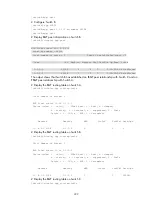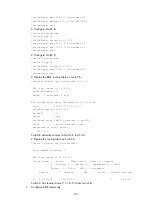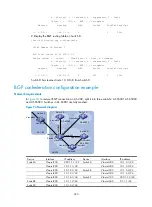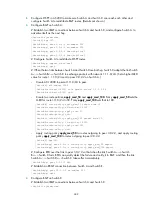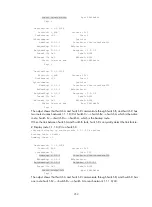
243
Not advertised to any peers yet
# Display the BGP routing table on Switch D.
[SwitchD] display bgp routing-table
Total Number of Routes: 1
BGP Local router ID is 4.4.4.4
Status codes: * - valid, ^ - VPNv4 best, > - best, d - damped,
h - history, i - internal, s - suppressed, S - Stale
Origin : i - IGP, e - EGP, ? - incomplete
Network NextHop MED LocPrf PrefVal Path/Ogn
*>i 9.1.1.0/24 10.1.3.1 0 100 0 100i
[SwitchD] display bgp routing-table 9.1.1.0
BGP local router ID : 4.4.4.4
Local AS number : 65001
Paths: 1 available, 1 best
BGP routing table entry information of 9.1.1.0/24:
From : 10.1.3.1 (1.1.1.1)
Relay Nexthop : 0.0.0.0
Original nexthop: 10.1.3.1
AS-path : 100
Origin : igp
Attribute value : MED 0, localpref 100, pref-val 0, pre 255
State : valid, internal, best,
Not advertised to any peers yet
The output shows the following:
{
Switch F can send route information to Switch B and Switch C through the confederation by
establishing only an EBGP connection with Switch A.
{
Switch B and Switch D are in the same confederation, but belong to different sub ASs. They
obtain external route information from Switch A and generate the same BGP route entries; it
seems like they reside in the same AS although they have no direct connection in between.
BGP path selection configuration example
Network requirements
, all switches run BGP. Between Switch A and Switch B, and between Switch A and Switch
C are EBGP connections. Between Switch B and Switch D, and between Switch D and Switch C are IBGP
connections. OSPF is the IGP protocol in AS 200.
Configure routing policies, making Switch D use the route 1.0.0.0/8 from Switch C as the optimal.

